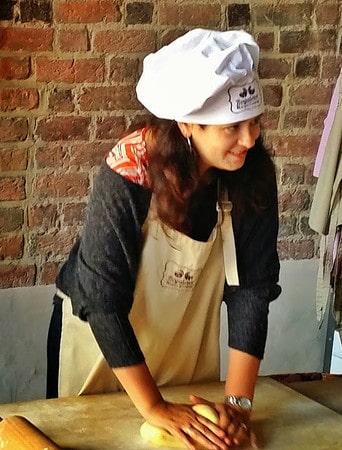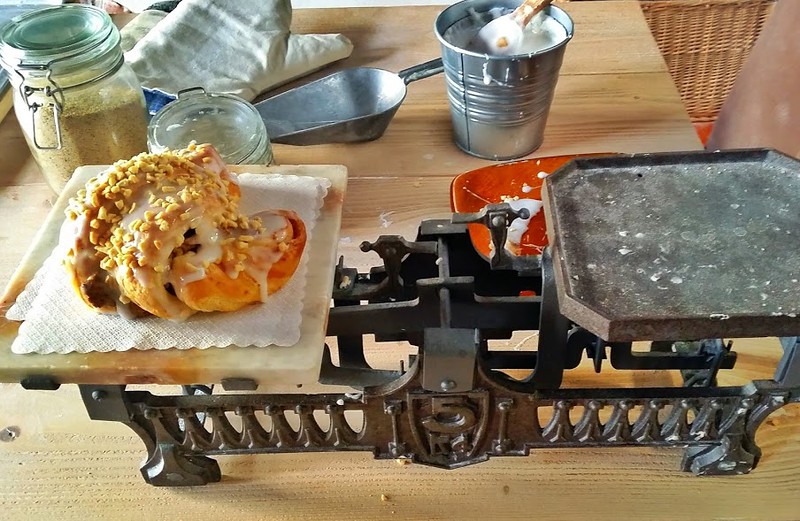Have you ever eaten a legally protected croissant? One that is not only protected in Poland but in all of the EU? You have if you’ve eaten a St. Martin’s Croissant, better known as Rogale Świętomarcińskie in Polish.
When I first heard this at the Croissant Museum in Poznan, which incidentally is really an interactive experience rather than a museum I thought it was a joke they played on all the tourists.
I mean, come on, what does a croissant need protecting from? Dirty hands? Dentures?

But they were serious; the recipe is protected under EU law. This means that not just anyone can make a Saint Martin’s croissant; you must use the exact recipe and have the legal rights to make and sell it. Talk about strict requirements!
And just like how Gucci has its fakes, so does Saint Martin Croissant. Impostors that call themselves the Martin Croissant or some version of the real name
Related Reading: Best Soups from Around the World.

So just what makes a St. Martin Croissant so special?
Well, for one thing, they date back to 1891 when a Catholic priest in the St. Martin’s parish started a charity campaign: Help your neighbors survive winter. You can read more about the history of the St. Martin Croissant here.

Or it could be it’s 81 layers, yep 81! And you have to wait 30-35 minutes between each layer. Hope you’re patient with these crescent shape delights!
Needless to say, you’ll want to go for a hike afterward. I highly recommend hiking in Wielkopolski National Park. It’s located 15km from Poznan and is a great way to burn off those calories.
Or, if you’ve indulged in a lot of croissants, then consider a multi-day hiking tour to burn off all those calories like the Tour du Mont Blanc or our Croatia hiking tour.

Between the layers of this crescent-shaped pastry, you’ll find white poppy seeds, raisins, orange peel, walnuts, biscuit crumbs, egg yolks, and almond essence.
Here’s the recipe for the St. Martin’s Croissant (Rogale Świętomarcińskie), which I believe is the real deal, but don’t quote me.
So three hours later, you’ve rolled, filled, and waited. But have you made a Saint Martin’s Croissant? There’s only one way to find out!
This famous croissant must weigh between 150 – 250 grams. Otherwise, it doesn’t qualify…sniff…sniff…
You can enjoy this Danish pastry with lukewarm butter with a side of hot coffee or lukewarm milk. Or you can indulge in it by itself!

By some sort of fluke, or more likely under the pastry chef’s expert guidance, I made a St. Martin’s Croissant.
However, sadly being celiac, I couldn’t eat it. My loss, however, was my partner’s gain, and he enjoyed the frost crescents immensely, so much so that he was too full for dinner.

That’s the thing about a St. Martin’s Croissant; the 81 layers of pastry is filling. That’s why locals only eat them seasonally, like on St. Martin’s Day or at Christmas time!
Having said that, the people of Poznan still manage to eat a lot of them. 700,000 of them on St Martin’s Day alone!
Just imagine the amount of sugar glaze, poppy seed filling, cups of flour, and crescent roll dough made and consumed during the holiday!
Furthermore, St. Martin’s (or Martin) Days are also independence days in Poland. St. Martin, also known as Martín de Tours, was once one the most popular Catholic saints in Europe and is now a patron saint of France, Spain, Italy, Portugal, and many more.
In November, this city turns into croissant-land, with local bakeries rolling out huge trays of calorie-dense Rogal świętomarciński. A.K.A. Saint Martin Croissants.
Related Reading: 10 Finnish Foods You Need to Try

But here’s another secret about Poznan’s beloved croissant. The best ones may actually be the (gasp….) impostors, not the actual ones. So long as you know the basic recipe or the traditional recipe you can make your own!
One local, who wished to remain anonymous for his safety, stated that there’s no room for improvement or experimentation. The ingredients and measurements are always the same for a St. Martin’s Croissant.
On the other hand, the impostors are free to add a dash of cinnamon here or a dash of nutmeg there.
They’re free to experiment and improvise since they don’t have to adhere to the strict recipe required when making a Martin’s Croissant.
(Did you catch it?…. The impostor name?).
Try both and let me know what you think!
Know Before You Go to the Croissant Museum in Poznan:
- The Croissant Museum is an interactive experience. Be prepared to get your hands covered in dough.
- Croissant Shows are at:12:30, 13:45, 15:00. Additional showtimes are possible with groups of 15+ people.
- The museum is closed on Mondays and selected public holidays. Check the Museum’s site (listed above) before you go.
- It’s located on the Old Market Square in Poznan (which I think is one of the prettiest in Europe). You access it from the side street, not from the square.
Where to Stay in Poznan
5-Star
Sheraton Poznan Hotel offers spacious, bright rooms that are comfortable. The hotel is well located to explore your surroundings and offers a heated indoor swimming pool. There’s also a fitness center, a sauna, and two restaurants that serve excellent cuisine.
4-Star
IBB Andersia Hotel is located in the Stary Browar Shopping center. This beautiful design hotel offers guests glass-floored bathrooms with heating and a hearty breakfast buffet. The hotel also has an indoor swimming pool, sauna and steam bath that are free for guests to use.
3-Star
Park Inn by Radisson Poznan is located just 300m from the Poznan city hall. The hotel includes a fitness center and an excellent buffet breakfast each morning. The rooms are comfortable and spacious and you can request a room with an adjoining terrace.
There is nothing better than a warm croissant. What better croissant to indulge on than one that is so amazing that it is legally protected.
Note: Poznan City Hall made my visit to the Croissant Museum possible. As always, all opinions are my own.
